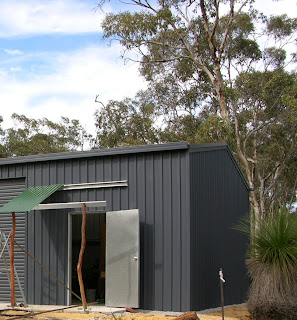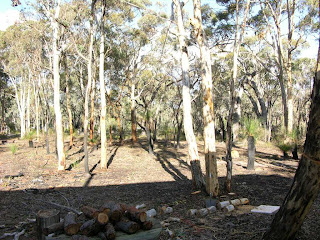Want to learn more about yourself, your culture and your native country than you ever thought possible? Then do what I did. Move overseas for a decade or so.
I've been in Australia for 10 years give or take, and I'm still finding out new things. Things about America as often as about Australia. For instance, I never understood the extent to which Americans unconsciously rely on Shopping and Food as the solution to everything. And don't get me started about shopping FOR food.
Too late!


Looking for your favorite breakfast cereal? Forget it. There are two varieties of sugary cereals in Australia. One of them is fruity-rings and the other I can't even think of because it's so incredibly boring. Australia's coasts were charted by Captains Cook, Dampier, Hartog and Flinders, but Captain Crunch evidently never ventured this far south. Count Chocula simply cannot endure the exeptionally bright sunlight. Australian school children are so good at reading that letter-based sweetened oat cereal is completely unnecessary (and unavailable). Although there are large numbers of Irish here, none of them seem to have remembered to bring their Lucky Charms. They say Trix are for kids, but they really mean only non-Australian kids. Instead, the typical Australian breakfast table is provided with something called Weet Bix. I was offered this during my first week here. My host asked if we have something similar in America. After chewing for a moment, I said, "Yes. We call it 'Cardboard.'"
I subsist largely on a diet of red meat and peanut butter sandwiches, so my first forays into Australian grocery stores were not particularly ambitious. Yet they were still frustrating. If you buy beef here, don't waste your time or money on the cheap stuff unless you're going to stew it in a slow-cooker for a "fortnight" (an Australian unit of time equal to how long it takes a plumber to turn up). It took me a while to discover that really good beef was available, but you had to either drive to a cattle-raising area and dine at the local pub, or pay at least $15 per pound.
 |
| 64 oz (2 kg) Family Size |
One happy discovery was Lamb. If you're an American and you don't like lamb, you have excellent taste. Lamb is generally terrible in the U.S. But please give Australian lamb a try. It alone is worth the trip. Australian lamb is probably the third Best Thing about Australia in my opinion.

When I buy peanut butter in America, I have plenty of options. I can choose from 8 different brands, most of which come in five different sizes: Convenience size, Normal size, Family size, Economy size, and Preparing For Armageddon (44-gallon drum, your choice of smooth, crunchy, or super-chunk). In Australia, there are two brands and two sizes, the smaller of which is almost enough for one whole sandwich. Wow.
 |
Minnie Hamilton Cash in 1891
at age 19, on her wedding day. |
Because my Great-Grandmother Cash was a southern lady who went out west in 1900, my family still has a taste for Southern cooking and some recipes handed down. My own mother, in addition to being a professional educator, accomplished pianist, one of my three favorite artists, and an excellent driver, is also a wonderful cook. I failed to appreciate this fact until I moved out on my own. The following Thursday I phoned her up and asked how she manages to get her pie crusts so tender and flaky.
When I came to Australia, my problem was first converting all of Minnie Cash's recipes into metric. That felt weird, and was harder than it sounds. Butter in the US is measured in ounces of volume, but in Australia is measured in grams of mass. Does anyone know the density of butter? I do.
The other problem was locating all of the ingredients. Corn flour? Well, I bought a rectangular box that said Corn Flour right on the front, but it turned out to be Corn Starch instead. I should have expected that, because when I asked for corn starch, I was shown an aerosol can with a picture of a shirt on it. It took me a few years to work out that corn meal was filed under P for Polenta. (For some reason, in Australia the most-spoken language other than English is
Italian.)
 |
| Another Waffle Catastrophe |
Crisco? Nope. Not available here. Closest approximation is something called "Copha" and it comes in a very small block and not a large tub. It's also hard and doesn't blend right. Bisquick? I wish. I've never yet had a really good waffle here. Baking powder? There is something by that name used for the same purpose, but it's never real baking powder. It tastes funny. It doesn't rise half as well. None of my recipes worked. I tried every brand (both of them). Today I get all my baking powder from the US.
Even ordinary wheat flour seems to respond differently to moisture. After converting all my recipes into metric, I've had to adjust the proportions of everything. To this day I've never managed to make a respectable Cornbread that my great-grandma Cash would approve of.
And then there's the language barrier. Biscuits (a Cash recipe: flour, salt, baking powder, lard, milk) are one of my favorite breakfast foods, but in Australia, a cookie is a biscuit, and a biscuit is a "scone" (rhymes with gone) served in the afternoon, not at breakfast. Where I'm from a "scone" (rhymes with bone) is a yeast dough fried in oil, served with powdered sugar and honey. Mentioning biscuits therefore causes significant confusion and misunderstanding.
Cilantro
, a necessary ingredient for Mexican food, doesn't exist here. Unheard-of. Unobtainable. Impossible to get. Coriander, on the other hand, is plentiful and easily obtainable. Fortunately, they are exactly one and the same thing.
People often ask me what Australian cuisine is like. Well, that's a hard question to answer. Australia doesn't really have a cuisine of its own, unless you count plain over-cooked meat, which isn't exactly unique. I've always held that the biggest problem with Australia is that it was started by Britain, home of such culinary innovations as boiled beef and exotic dishes such as "potatoes." From the English, we have meat pies, sausages with big, hard pieces of gristle or cartilage in them, and fish and chips.
While TV shows about cooking and food are extremely popular here, Australians in general seem to take very little notice of what they eat or how they prepare it. "It's food if you can keep it down ya." Baked beans and toast is eaten breakfast, lunch and dinner by the arch-typical "Aussie Battler" (the economically disadvantaged, and proud of it). A "burger" can be anything including sometimes beef, served on bread with a fried egg and sliced beets. Yes, beets, as in "that gross vegetable nobody eats on purpose."
 |
| World's Best Root Beer. |
I've mentioned the absence of Mexican food before. There is something called "guacamole" for sale in the stores here. It is a smooth, pale green, bland dip made from cream and has real, genuine "Avocado Guacamole" printed right on the packaging. Those letters are the only relation this product bears to actual Guacamole. In Australia, the best guacamole is that which I make myself. It's chunky, spicy, and it doesn't involve cream in any way. I also make the best burritos in the entire country, as well as the only serviceable flour tortillas (flour, lard, salt water, four hours, then roll so thin you can see through it). My own pizza is also the best approximation to genuine American pizza. Unless you happen to like beets.
 |
| World's Best Ginger Beer |
While Coke and Pepsi are needlessly abundant, the more interesting soft-drinks aren't. The only Root Beer available in Australia is canned A&W imported from Singapore. As an alternative, I've discovered that the world's best Ginger Beer is made in Tasmania (the forgotten Australian state).

Why are silly things like food important to me? I didn't realize they were until they weren't available. The only way for a fish to understand water is to take it out for a while. Will I ever go back to the US? As long as I can get an occasional fix of Mexican food, Root Beer and waffles every so often, and have a supply of proper baking powder, I'm content to stay for a while.
The Lamb is excellent.
| Southern Cooking: | | Australian Cooking: |
|
|
|
 Nick: No, actually I'm from Australia.
Nick: No, actually I'm from Australia.




































